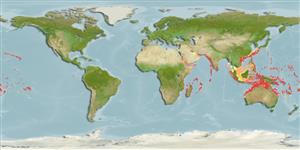Environment: milieu / climate zone / depth range / distribution range
Ecologia
marinhas associadas(os) a recifes; intervalo de profundidade 20 - 220 m (Ref. 5222). Tropical; 36°N - 27°S, 37°E - 143°W (Ref. 5222)
Indo-Pacific: islands in tropical and subtropical waters from the western Indian Ocean to Jarvis Island (Line Islands, Kiribati) and French Polynesia (Ref. 4787), including Bassas da India (Mozambique Channel) (Ref. 5222).
Tamanho / Peso / Idade
Maturity: Lm ? range ? - ? cm
Max length : 50.0 cm TL macho/indeterminado; (Ref. 5222); common length : 30.0 cm TL macho/indeterminado; (Ref. 9137); peso máx. publicado: 2.0 kg (Ref. 5222)
Espinhos dorsais (total) : 11; Raios dorsais (total) : 16 - 17; Espinhos anais: 3; Raios anais : 8. Similar to E. fasciatus, differing primarily by having straighter head profile and longer snout, red rather than black tips on spinous dorsal fin (Ref. 37816). Distinguished by the following characteristics: adults dull yellowish orange to brownish red, each scale on the dorsolateral part of the body with dark greenish grey spot; usually 5 faint dark bares on body, 2nd and 3rd bars extend onto the spinous dorsal fin where they are dark brown; dorsal fin greenish brown, soft rayed part darker than rest of the fin, outer triangular part of interspinous membranes dark red, set off from the rest of the fin by an orange-yellow stripe; dark greenish brown dorsal fin margin of caudal fin; dark red or brown line along base of dorsal fin; narrowly edged orbit, except anteriorly, with dark red; pale blue line adjacent to the red rim of the orbit and completely surrounding eye; body depth contained 2.5-3.1 times in SL; head length 2.4-2.6 times in SL; flat to slightly convex interorbital, dorsal head profile slightly convex; rounded preopercle, finely serrate; sinuous upper edge of operculum; snout length 3.5-3.9 times in HL; subequal anterior and posterior nostrils; maxilla reaches below rear half of eye; 3-4 rows of teeth on midlateral part of lower jaw; pair of short fixed canines at front of both jaws; numerous pyloric caeca (Ref. 89707).
Adults are found in depths of 70 to 220 m on outer reef slopes; the young in depths of 20 to 40 m (Ref. 89707). Also caught with vertical longlines.
Ciclo de vida ou comportamento de acasalamento
Maturities | Reprodução | Spawnings | Egg(s) | Fecundities | Larvas
Heemstra, P.C. and J.E. Randall, 1993. FAO Species Catalogue. Vol. 16. Groupers of the world (family Serranidae, subfamily Epinephelinae). An annotated and illustrated catalogue of the grouper, rockcod, hind, coral grouper and lyretail species known to date. Rome: FAO. FAO Fish. Synop. 125(16):382 p. (Ref. 5222)
Status na Lista Vermelha da UICN (Ref. 130435)
Ameaça para os humanos
Harmless
Uso pelos humanos
Pescarias: pesca de subsistência; peixe esportivo: sim
Ferramentas
Relatórios especiais
Baixar XML
Fontes da internet
Estimates based on models
Preferred temperature (Ref.
123201): 20.8 - 28.1, mean 26.1 °C (based on 472 cells).
Índice de diversidade filogenética (Ref.
82804): PD
50 = 0.5000 [Uniqueness, from 0.5 = low to 2.0 = high].
Bayesian length-weight: a=0.01175 (0.00571 - 0.02419), b=3.04 (2.88 - 3.20), in cm total length, based on LWR estimates for this Genus-body shape (Ref.
93245).
Nível Trófico (Ref.
69278): 4.0 ±0.65 se; based on food items.
Resiliência (Ref.
120179): médio(a), tempo mínimo de duplicação da população 1,4 - 4,4 anos (Preliminary K or Fecundity.).
Fishing Vulnerability (Ref.
59153): Moderate vulnerability (40 of 100).
Nutrients (Ref.
124155): Calcium = 26.1 [12.5, 54.2] mg/100g; Iron = 0.474 [0.256, 0.953] mg/100g; Protein = 18.5 [16.9, 19.9] %; Omega3 = 0.142 [0.090, 0.227] g/100g; Selenium = 44.3 [26.0, 76.1] μg/100g; VitaminA = 188 [55, 660] μg/100g; Zinc = 1.21 [0.85, 1.69] mg/100g (wet weight);
